










Please upgrade your browser for modern web functionality, a better user experience and improved security.
Upgrade my browser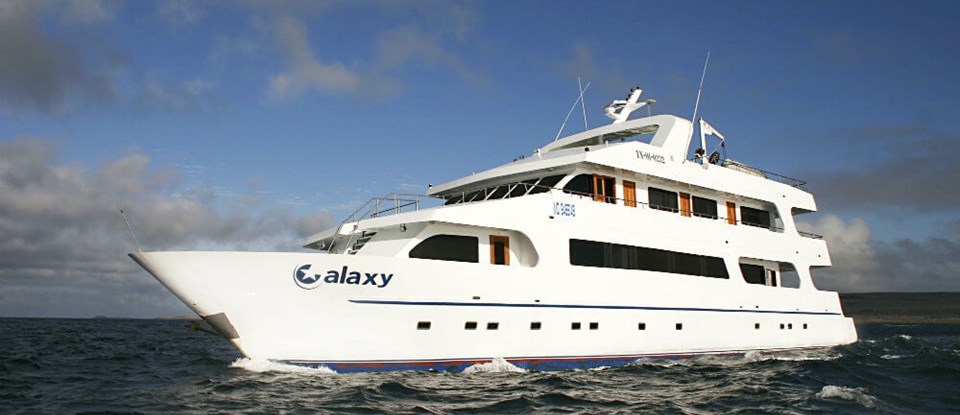
A first class, contemporary motor yacht for up to 16 guests.
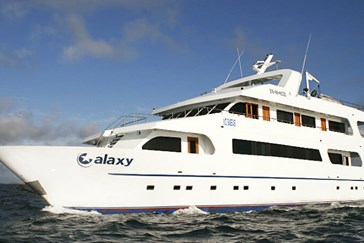
The Galaxy
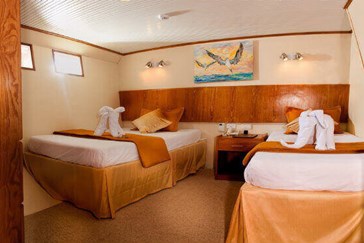
A spacious twin cabin
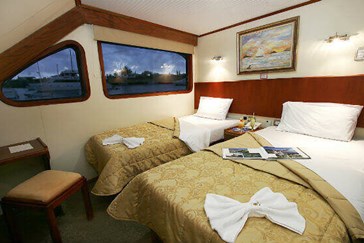
Upper deck cabin
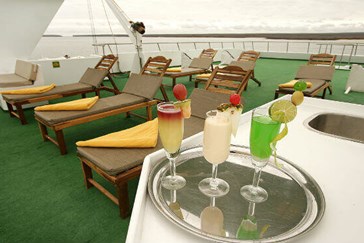
The sun deck with loungers to enjoy the sunshine
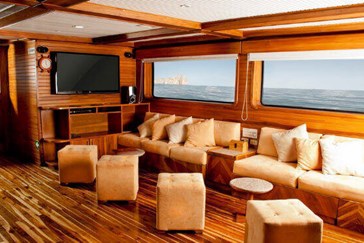
The comfortable lounge on the Galaxy
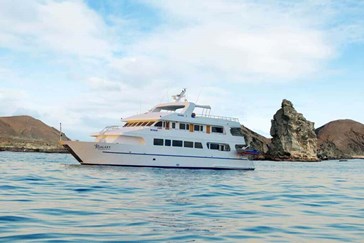
Galaxy
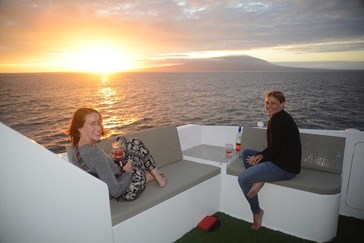
Glorious sunsets await

Exploring by zodiac
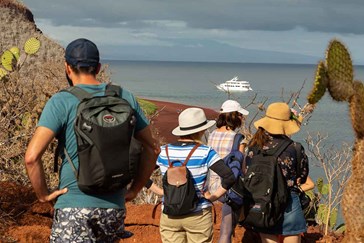
Enjoy daily excursions with qualified naturalist guides
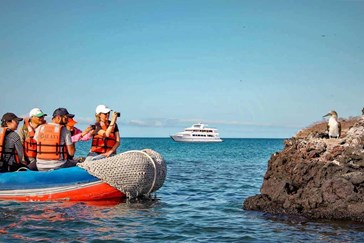
Get close up to nature
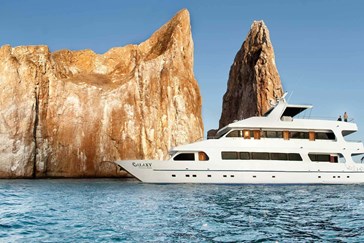
Galaxy at Kicker Rock












Specialist Knowledge
Need some help with your trip? Our advisors have travelled extensively and using their firsthand knowledge & experience can help craft your perfect holiday.The Galaxy Yacht offers a spacious base to explore the Galapagos Islands. The sun deck is a fantastic area to enjoy Galapagos' landscapes, dine al fresco and relax. On the main deck, enjoy the contemporary dining area, lounge, bar and small library.
Other activities onboard are hiking, snorkelling, swimming, kayaking, and watching the wildlife. Snorkelling gear (mask, tube and fins) and kayaks are provided free to complete your adventure in the island.
The Galaxy has 9 beautiful and comfortable air-conditioned double cabins for 16 passengers; 3 on the upper deck, 3 on the main deck and 3 on the lower deck. The Galaxy prides itself of offering a very personalised service, from the crew and on board naturalist guide who will take you ashore on daily excursions and deliver informative talks and lectures each evening.
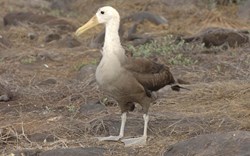
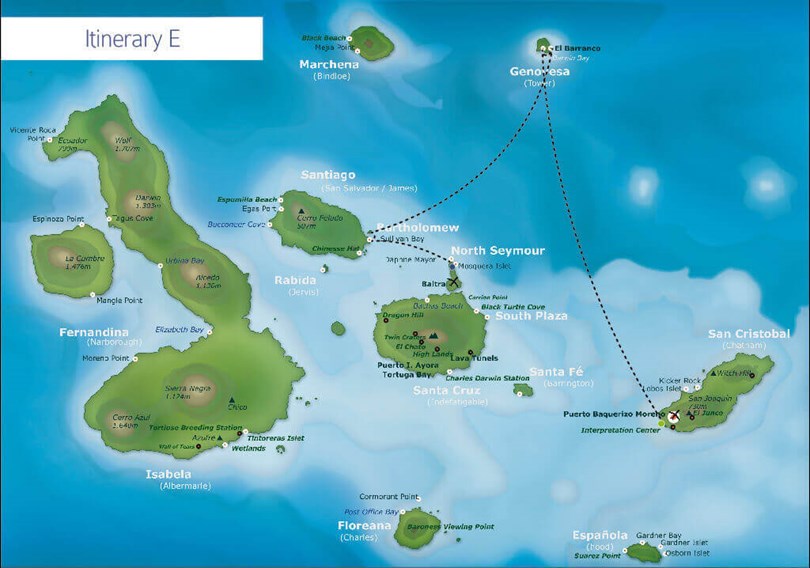
Saturday to Tuesday
Dat 1 - BALTRA ISLAND– MOSQUERA ISLET
Arrive to Baltra Island and transfer to the M/V Galaxy for your 3 night cruise.
Visit Mosquera Islet, located between Baltra Island and North Seymour. Here, we find the biggest sea lions colony; also it is possible to observe several species of birds. Enjoy of its white sand beach. Hiking.
Day 2 - SANTIAGO ISLAND: SULLVAN BAY & BARTOLOME ISLAND
Morning visit to Santiago Island, where we hike on this unique landscape composed of lava flows covering an extensive area, with interesting flora and fauna of lava pohoehhoe or cords, hornitos and mollugo that grow in the lava. Lava Colonizers can also be observed.
Afternoon visit to Bartolome Island, where we land on the beach and enjoy a guided walk, swimming, snorkelling and photography. We will walk to the top (114 m) of a cliff to observe pioneering plants such as Tequila, Chamaesyce and Scalesia. The island is formed by cones, pipes of lava by where lava once flowed. We continue to the south beach through mangrove swamps and vegetation of dunes and to the North of the Bartolome Island where we can observe the islands as Santiago, Rabida, Isabela. We can also find penguins in the Rock Pinnacle.
Day 3 - GENOVESA ISLAND: BARRANCO & DARWIN BAY
We visit Barranco, also known as Prince Felipe’s stairs. Here, we walk on the Barranco path, observing tropical birds, petrels, common frigate, red-foot boobies, mask boobies, dove and finches.
After lunch, we visit Darwin Bay - a beautiful coral beach, and enjoy short walks, photography, swimming and snorkelling. Genovesa Island is a small island and close to the beach we will find a small forest of mangrove swamp where we will discover a colony of frigates, marine iguanas, red-foot boobies and mask boobies, the great terrestrial finch, seagull, herons and finch of cactus. After exploring there is time to enjoy swimming in the bay.
Day 4 - SAN CRISTOBAL ISLAND: INTERPRETATION CENTRE - DEPARTURE
We arrive at San Cristobal Island and visit the excellent Interpretation Centre. Here, you will get a deeper understanding of the volcanic formation of the islands, the evolution of the species, the history of the human settlements and the islands complex ecological systems and model of management.
Continue to the airport for your onward flight back to the mainland.
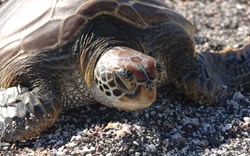
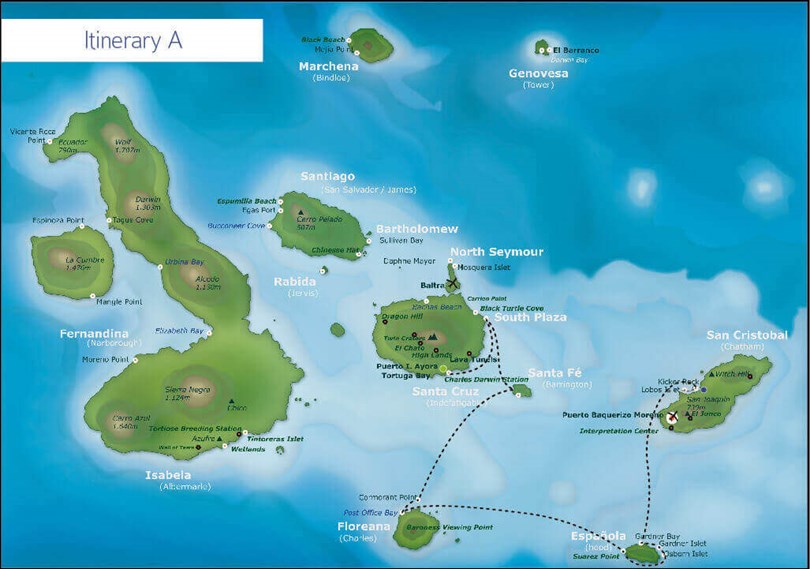
Tuesday to Saturday:
TUESDAY: SAN CRISTOBAL ISLAND
San Cristobal airport. Reception at airport. Transfer IN. Welcome on board Galaxy Cruise. Welcome drink and lunch.
PM LOBOS ISLAND. Panga Ride, swimmingand snorkeling. Description of the place: this place is the habitat of seals, frigates, finches, marine iguanas, lava lizards, and the small endemic Galapagos snake. Here, we can swim and snorkeling in the same place. Leon Dormido: This is formed by two rocks of approximately 148m above sea level named thus by its similitude with a lion we will pass between both rocks but we will not disembark because is not possible to do it.
WEDNESDAY: ESPAÑOLA ISLAND
Breakfast early in the morning. Our first visit:BAHIA GARDNER: wet landing, activities for this visit: short walking, swimming, snorkeling, and observation of seals colony.
The sea lion is one of the animals in Galapagos which gets the total attention of the visitors in the Galapagos: they are curious and playful, but at times aggressive; they are nice and loving, but also lazy. In Gardner Bay, we are going to find many of them relaxing in the beach enjoying of the sun. Snorkeling in the area where we will be able to swim with them, besides you observe these fascinating animals, we will swim with the sea turtles, diversity of tropical fish, marine iguanas etc. We will return to the ship, to sail toward the following island. Lunch.
SUAREZ POINT: dry landing, activities that were carried out in this place: walking; recommendable clothes: sports shoes, hat, cap, solar lotion. There is not color more amazing and outstanding in this tropical desert island that the blue-foot boobies; they have an impressive form to “greeting” and it is a real spectacle to see the ritualistic parade of the entourage. In several islands we can admire this bird due to that nests and feed are located in diverse places close to the coast. In this place we will be able to observe the Albatross with a weight from three to four kilograms and an importance of more than two meters, this creature of aristocratic aspect is one of the largest birds of the islands. Around twelve thousand couples have their nests in the Española Island (some few in the Silver Island near of main land Ecuador). This specie is considered endemic from this island during our walking we will be able to observe these fantastic birds, we will be part of the beautiful and only landscapes that offers this island. Important Note: Albatross will be not possible to see between January and March. Also we will observe colonies of marine iguanas, zayapas, mask boobies, finches, Española cucuves, and seagulls unique of the island. Our walking will be for lava rock path where we will be able to admire the hollow blowers. The vegetation of this island is of red mangrove. Delicious Snacks and fresh beverages expect for you.
THURSDAY: FLOREANA ISLAND
Breakfast early in the morning. Our first visit will be POST OFFICE (Mail Bay): Wet landing. Activities in this place: short walk, swimming, snorkeling, review of the mail. Description of the Place: it is situated to the north of Floreana Island. The Post Office Bay name is because of Capitan James Colnett installed an empty Ron barrel, to use it as post office for the whaling fleets that frequented for a long time the Galapagos Islands. You can send some postcards from here to your friends and relatives or interchange letter to deliver in their destiny. Return. Delicious snacks and beverages will be expecting for you and lunch
PUNTA CORMORANT: wet landing, snorkeling and short trekking. This point is located at west of Floreana Island and it is famous to has a dark green beach due to the great quantity of olivine crystals. You can see many marine invertebrates, as well as also sea lions, sea iguanas, the frigates and pelicans. Second visit: DEVIL´S CROWN: Activities in this place: panga ride and optional swimming. Panga ride around of a small island, this place was a satellite islet of the island Floreana. Here, we will find a group of rocks that seem to a crown, due to the constant erosion caused by the sea. It is one of the better places to do snorkeling (superficial diving) in the interior and around of the crown, excellent visibility to admire a great variety of fishes and sea animals.
FRIDAY: SANTA FE ISLAND & SOUTH PLAZAS ISLAND
SANTA FE: Wet landing, activities for this day: hiking, swimming and snorkeling. Description of this place: With 24 Km2 and 60 meters of height above sea level, it is an almost central island that has a unique place of visit: an incredible bay with turquoise water protected by a natural barrier of rocks and from you can appreciate colonies of seals and hawks flying over. It is home of one of the two species of land iguanas that have the islands, their main food are the leaves and fruits of the large and thick cactus. Crabs, nocturnal herons, marine iguanas, cucuves and land doves are seen frequently. The Bay is excellent place to swim and to do snorkeling. Marine Tortoises, rays, sea lions and tropical fishes are an amazing attraction! Snacks and refreshing beverages expect for you on board. Lunch. Navigation toward South Plazas Island.
SOUTH PLAZAS are two small islands, created by land uplift where land iguanas are known to be smaller; they nest during warm time. The hike goes along an extraordinary cliff where sea birds nest.
Approximately, in this Island there are 1000 sea lions (Zalophus wollebaeki)and they are located in south side of Plazas
SATURDAY: SANTA CRUZ ISLAND
We take our breakfast very early in the morning. Our luggage and all your belongings should be list to check out in the ship, our last visit: ESTACION CHARLES DARWIN.
Charles Darwin Station is located in the Main Port of Santa Cruz Island, we will take our private bus that take us to the entrance of the center of breeding where we go to appreciate tortoises and land iguanas in captivity, this center is the main site of breeding of the islands. Animals that were in danger of extinction in the different islands are maintained in captivity and thanks at dedicated work of several institutions some species are saving, here was where the most famous tortoise “the Solitary George” the last survivor of the species of Pinta Island lived. Transfer Out.
** ITINERARY IS SUBJECT TO CHANGE**
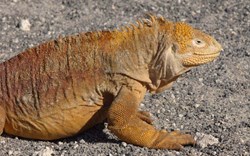
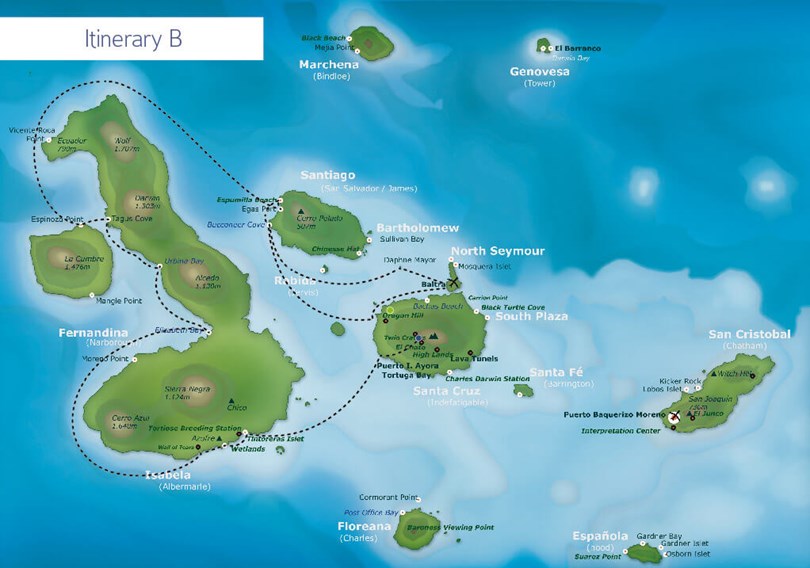
Saturday to Thursday
SATURDAY: BALTRA ISLAND – SANTA CRUZ: HIGHLANDS
Arrive to Baltra Island. This island is known to be inhabited by militaries only. On this island is located one of our mains Galapagos airports. Once you arrive your guide will be waiting for you. Transfer to Santa Cruz Island, we cross the Itabaca Chanel (from airport to this place is around 15 minutes), after this we take our private bus to Puerto Ayora.
Once we arrive to Puerto Ayora, we will go direct to Galaxy Yacht: cabin accommodation and take lunch. After lunch, our first visit is HIGHLANDS OF SANTA CRUZ,where we have a trekking and we will find the giant tortoises in their natural habitat, this is a natural spectacular. For this visit we recommend to use sport shoes, long pants, raincoat, hut and sun block. Back to Puerto Ayora. At the night we have a welcome cocktail and the formal presentation of our crew by Capitan. Briefing for next day.
SUNDAY: ISABELA ISLAND
TINTORERAS: Located in the bay of Puerto Villamil, this small island surrounded by calm turquoise waters has an easy trail with great landscapes and very interesting fauna. Along the trail we will see large numbers of Marine Iguanas basking in the sun, lava lizards, herons, gulls and sea lions. In the coves, it is easy to find Sea Turtles, rays and even Penguins. Among the many cracks and channels in the coast sometimes we can see White-tipped Reef Sharks (in Spanish “Tintoreras”). After the visit, we will snorkel in a sheltered area where it is possible to see many tropical fish, Rays, Sea Turtles, Reef sharks and with a bit of luck, penguins. Return on board for lunch.
PM BREEDING CENTER – HUMEDALES & WALL OF TEARS: The Breeding Center is located 1.5 Km from Puerto Villamil. This place is dedicated to the reproduction of several species of tortoises in captivity; we will find 330 tortoises between youthful and adult. The Breeding Center has beautiful gardens composed by native plants. Visit Humedales: complexes of paths which include sites like: The Orchilla Hill, from this viewpoint you can admire the bay, Puerto Villamil, Volcano Sierra Negra, islets and rocks. El Estero, Poza Escondida, Poza Redonda, Tunel Del Estero are others paths located in Humedales area, each one with its beautiful landscape and characteristic. After that we have a walking to Wall of Tears, a big wall build by prisoners; in our pathway to this site, we will see land tortoises.
MONDAY: ISABELA ISLAND
ELIZABETH BAY:This is one of the island’s breeding sites for penguins. Located on the west coast of Isabela, Elizabeth Point is a marine visitor site. Visit red mangrove cove Brown pelicans, flightless cormorants, spotted eagle rays, golden rays and
URBINA BAY: This place is located at the base of Alcedo Volcano between Elizabeth Bay and Tagus Cove. Wet landing. Trail length is around 3.20 Km; during this walking we can observe land iguanas, hawks, tortoises; also it is possible to see red and blue lobsters.
TUESDAY: ISABELA ISLAND & FERNANDINA
ISABELA ISLAND: TAGUS COVE: It is located at west of Darwin Volcano in Isabela Island. During our walking we will find several inscriptions (names of boat’s pirates) since 1800. Tagus Cove name has its origin of an England ship which crossed the island looking for Galapagos tortoise to feed the crew. From this area we can admire the Darwin Lake which has salt water and its deep is 9metes approximately, there are no fishes. It is very easy to see different species of birds. Lunch
FERNANDINA ISLAND – ESPINOZA POINT: Fernandina is the 3rd island bigger of Galapagos and has just one visit place: Espinoza Point.
Espinoza Point is famous site because you will find big colonies of marine iguanas and to be the unique place where the flightless Cormorant lives, Galapagos penguin, hawk, snakes of Galapagos and many other. From Espinoza Point we can admire Fernandina Island and its volcano which last eruption was on May 2005.
Fernandina is the only island that doesn’t have any mammal introduced and the open areas are very fragile. In nesting time of marine iguana (January to June) we have a lot care when we are walking. Return to Galaxy.
WEDNESDAY: SANTIAGO ISLAND
SANTIAGO ISLAND: EGAS PORT: In this site we find a black sand beach; at south of this beach there is a volcano called Pan de Azucar, it has volcanic deposits which have contributed to the formation of this black sand beach.
The crater of this volcano has a salt lake which in warm time becomes dry and it is possible to appreciate a salt mine. Between 1928 and 1930 there were some explorations to this mine but they didn’t function; additionally, it caused damages to the environment because of workers use endemic woods. It is not allowed go down to salt mine.
Return to Galaxy. Lunch
SANTIAGO ISLAND: ESPUMILLA BEACH & CALETA BUCANERO: One of the main attractions of this site is a Palo Santo wood, the beach and landscape; the beach is a very important site for tortoises because they use this place for nesting.
Once time, the pigs were the main predatory of tortoise’s eggs; pigs were eradicated with the creation of Isabela Project.
THURSDAY: DAPHNE MAYOR OR DRAGON HILL – TRANSFER OUT
DAPHNE MAYOR: is a volcanic tuff cone, formed by successive explosions produced by the mixture of lava and water. Galaxy will navigate around the Island.
OR
DRAGON HILL: The visitor’s site at Dragon Hill is located in northwestern Santa Cruz Island, and consists of a trail that runs through three different environments at just 1,600 m long.
Transfer to the airport
** ITINERARY IS SUBJECT TO CHANGE**
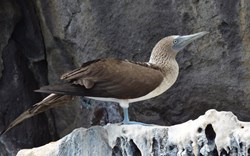
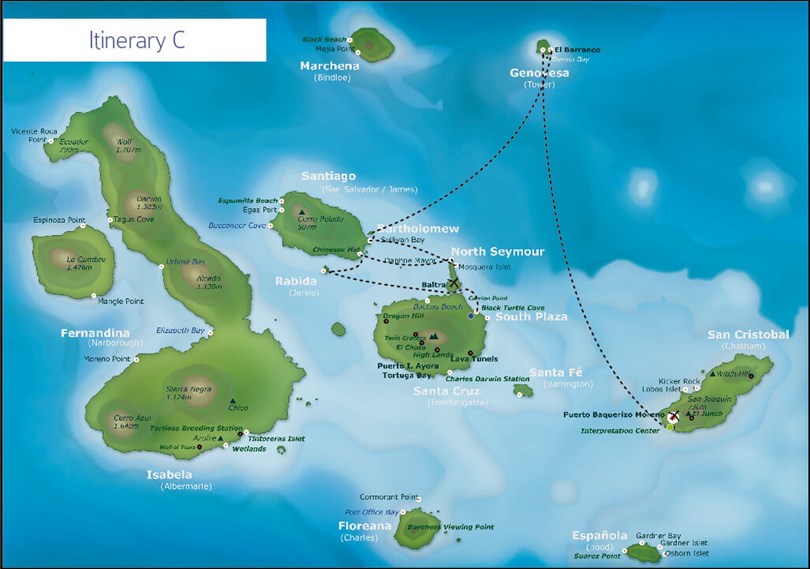
Thursday to Tuesday
THURSDAY: BALTRA ISLAND – SANTA CRUZ ISLAND: BLACK TURTLE COVE
Arrive to Baltra Island and Transfer In
SANTA CRUZ – BLACK TURTLE COVE: Welcome on board. After lunch our first visit is to Black Turtle Cove which is situated in the northern of Santa Cruz. This bay is surrounded by mangroves and is accessible by dinghy only. The superficial cove is a safe refuge for marine life. Black-tip reef sharks, marine turtles, and a variety of rays are often spotted here.
FRIDAY: RABIDA ISLAND – CHINESE HAT
RABIDA ISLAND: The visitor site is located on the east coast of Rabida Island, consists of a red sand beach, a coastal lagoon behind the beach, and a loop trail. The approximate distance of the trail is 1.1 kilometers.
The color of the rocks and sand on the beach is due to the very porous volcanic material, which with the help of environmental factors (rain, salt water and sea breeze, has acted as an oxidizing agent. The main attraction of the place is the red sand beach, scenery, aside from the vegetation of the arid zone and the presence of native and endemic species.
CHINESE HAT: A small islet located near the south-east coast of Santiago. It’s shaped like a Chinese hat when seen from afar. It is an island consisting of a cone type “Splatter” (lava ejected as drops and falls close to where it came from, which forms a cone inclined) that forms the summit and many lava tubes that go down to the coast.
On the west you can see pillow-type lava formations, which are an indicator that the flows were formed under the sea and have been raised upward, which is why coral heads are found on the lava. This visit provides an excellent opportunity for the interpretation of geological features such as lava tubes and lava flows.
The trail is 700 m (round trip) and the minimum time it takes this trek is half an hour.
SATURDAY: NORTH SEYMOUR ISLAND – MOSQUERA ISLET
NORTH SEYMOUR: This Island was formed by the lifting of volcanic marine lava. Marine fossil where found in this island; the fossil dates from Pleistocene.
In 1932 the Capitan Alan Hancock and his crew took 72 land iguanas from Baltra Island and the iguanas were introduced in North Seymour Island; the reason of this change was that the iguanas could live in better conditions than in Baltra. The crew of Capitan Hancock found malnourished iguanas in Baltra; in 1934 colonizing people verified that the iguanas were in good conditions.
The vegetation of North Seymour is bushy and host nest of Real Frigates of Galapagos. Return to Galaxy. Lunch
MOSQUERA ISLET: This islet is located between Baltra Island and North Seymour. Here, we find the biggest sea lions colony; also it is possible to observe several species of birds. Enjoy of its white sand beach. Hiking.
SUNDAY: SANTIAGO ISLAND: SULLVAN BAY & BARTOLOME ISLAND
SANTIAGO ISLAND: SULLIVAN BAY: wet landing and hiking. Description of the place: all the road and the island is composed of lava flows that still they are virtually without eroding and they cover an extensive area, lava pohoehhoe or of cords, hornitos, mollugo, this plant grows in the lava. Lava Colonizers. Snacks and refreshing beverages expect for you.
BARTOLOME ISLAND: Dry landing, landing wet for the beach, activities to carry out in this island: walk, swimming, snorkeling, and photography. We will walk for a path to the top (114 m) pioneering plants that will observe in this place TIQUILIA, CHAMAESYCE, SCALESIA, the island is formed by cones, pipes of lava by where lava flow. Wet landing, path to the south beach through mangrove swamps and vegetation of dunes. North beach: Swimming and snorkeling will be the activities that are going to carry out. Since the top of the island Bartolome we will be able to observe the islands as Santiago, Rabida, Isabela. We can find penguins in the Rock Pinnacle.
MONDAY: GENOVESA ISLAND: BARRANCO & DARWIN BAY
BARRANCO: dry landing, activities: hiking.
Also known as Prince Felipe’s stairs. Here, we will have a walk for the Barranco path. In our journey we will observe tropical birds, petrels, common frigate, red-foot boobies, mask boobies, dove, and finches. Return to Galaxy. Lunch
DARWIN BAY: wet landing, coral beach, activities for this day: short walks, photography, swimming, snorkeling. The Genovesa is a small island situated to the north of Galapagos our unloading in Darwin bay will be wet. Near to the beach we will find a small forest of mangrove swamp where we will discover a colony of Frigates, marine iguanas, red-foot boobies and mask boobies, the great terrestrial finch, seagull, herons, finch of cactus. After this visit in land, we have the option that our passengers enjoy swimming in the bay. Snacks and refreshing beverages expecting for you
TUESDAY: SAN CRISTOBAL ISLAND: INTERPRETATION CENTER – TRANSFER OUT
INTERPRETATION CENTER: Dry landing. This center is location in the Main Port. After our breakfast we will go toward our first visit: Interpretation Center of San Cristobal. The most modern and sophisticated architectural space destined for the natural interpretation of Galapagos, where you can know from the volcanic formation of the islands, the evolution of the species, passing for the history of the human settlements to come to understand to its complex systems and model of management. Transfer out.
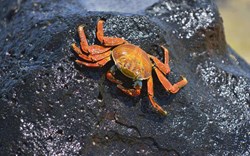
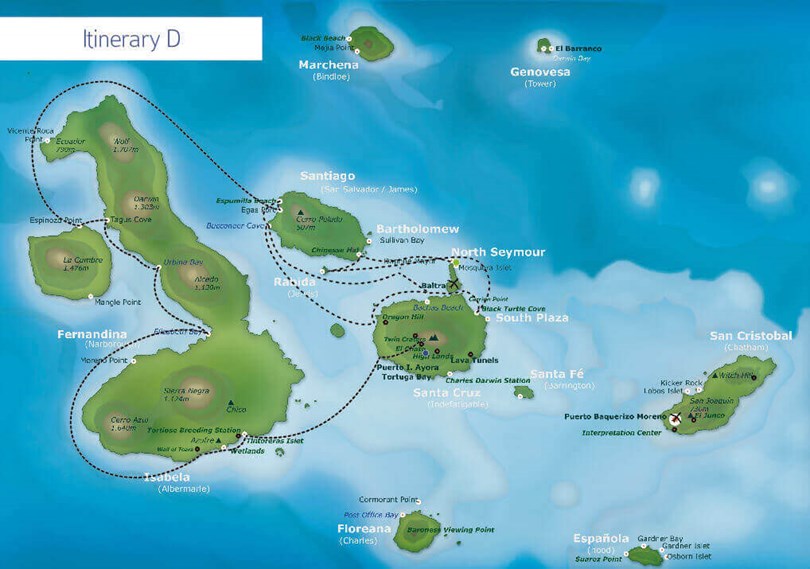
Saturday to Saturday
SATURDAY: BALTRA ISLAND – SANTA CRUZ: HIGHLANDS
Arrive to Baltra Island. This island is known to be inhabited by militaries only. On this island is located one of our mains Galapagos airports. Once you arrive your guide will be waiting for you. Transfer to Santa Cruz Island, we cross the Itabaca Chanel (from airport to this place is around 15 minutes), after this we take our private bus to Puerto Ayora.
Once we arrive to Puerto Ayora, we will go direct to Galaxy Yacht: cabin accommodation and take lunch. After lunch, our first visit is HIGHLANDS OF SANTA CRUZ,where we have a trekking and we will find the giant tortoises in their natural habitat, this is a natural spectacular. For this visit we recommend to use sport shoes, long pants, raincoat, hut and sun block. Back to Puerto Ayora. At the night we have a welcome cocktail and the formal presentation of our crew by Capitan. Briefing for next day.
SUNDAY: ISABELA ISLAND
TINTORERAS: Located in the bay of Puerto Villamil, this small island surrounded by calm turquoise waters has an easy trail with great landscapes and very interesting fauna. Along the trail we will see large numbers of Marine Iguanas basking in the sun, lava lizards, herons, gulls and sea lions. In the coves, it is easy to find Sea Turtles, rays and even Penguins. Among the many cracks and channels in the coast sometimes we can see White-tipped Reef Sharks (in Spanish “Tintoreras”). After the visit, we will snorkel in a sheltered area where it is possible to see many tropical fish, Rays, Sea Turtles, Reef sharks and with a bit of luck, penguins. Return on board for lunch.
PM BREEDING CENTER – HUMEDALES & WALL OF TEARS: The Breeding Center is located 1.5 Km from Puerto Villamil. This place is dedicated to the reproduction of several species of tortoises in captivity; we will find 330 tortoises between youthful and adult. The Breeding Center has beautiful gardens composed by native plants. Visit Humedales: complexes of paths which include sites like: The Orchilla Hill, from this viewpoint you can admire the bay, Puerto Villamil, Volcano Sierra Negra, islets and rocks. El Estero, Poza Escondida, Poza Redonda, Tunel Del Estero are others paths located in Humedales area, each one with its beautiful landscape and characteristic. After that we have a walking to Wall of Tears, a big wall build by prisoners; in our pathway to this site, we will see land tortoises.
MONDAY: ISABELA ISLAND
ELIZABETH BAYThis is one of the island’s breeding sites for penguins. Located on the west coast of Isabela, Elizabeth Point is a marine visitor site. Visit red mangrove cove: Brown pelicans, flightless cormorants, spotted eagle rays, golden rays and sea lions are often seen. Lunch E35K08
URBINA BAY:This place is located at the base of Alcedo Volcano between Elizabeth Bay and Tagus Cove. Wet landing. Trail length is around 3.20 Km; during this walking we can observe land iguanas, hawks, tortoises; also it is possible to see red and blue lobsters.
TUESDAY: ISABELA ISLAND & FERNANDINA
ISABELA ISLAND: TAGUS COVE: It is located at west of Darwin Volcano in Isabela Island. During our walking we will find several inscriptions (names of boat’s pirates) since 1800. Tagus Cove name has its origin of an England ship which crossed the island looking for Galapagos tortoise to feed the crew. From this area we can admire the Darwin Lake which has salt water and its deep is 9metes approximately, there are no fishes. It is very easy to see different species of birds. Lunch
FERNANDINA ISLAND – ESPINOZA POINT: Fernandina is the 3rd island bigger of Galapagos and has just one visit place: Espinoza Point.
Espinoza Point is famous site because you will find big colonies of marine iguanas and to be the unique place where the flightless Cormorant lives, Galapagos penguin, hawk, snakes of Galapagos and many other. From Espinoza Point we can admire Fernandina Island and its volcano which last eruption was on May 2005.
Fernandina is the only island that doesn’t have any mammal introduced and the open areas are very fragile. In nesting time of marine iguana (January to June) we have a lot care when we are walking. Return to Galaxy.
WEDNESDAY: SANTIAGO ISLAND
SANTIAGO ISLAND: EGAS PORT: In this site we find a black sand beach; at south of this beach there is a volcano called Pan de Azucar, it has volcanic deposits which have contributed to the formation of this black sand beach.
The crater of this volcano has a salt lake which in warm time becomes dry and it is possible to appreciate a salt mine. Between 1928 and 1930 there were some explorations to this mine but they didn’t function; additionally, it caused damages to the environment because of workers use endemic woods. It is not allowed go down to salt mine.
Return to Galaxy. Lunch
SANTIAGO ISLAND: ESPUMILLA BEACH & CALETA BUCANERO: One of the main attractions of this site is a Palo Santo wood, the beach and landscape; the beach is a very important site for tortoises because they use this place for nesting.
Once time, the pigs were the main predatory of tortoise’s eggs; pigs were eradicated with the creation of Isabela Project.
THURSDAY: DAPHNE MAYOR OR DRAGON HILL – SANTA CRUZ ISLAND: BLACK TURTLE COVE
DAPHNE MAYOR: is a volcanic tuff cone, formed by successive explosions produced by the mixture of lava and water. Galaxy will navigate around the Island.
OR
DRAGON HILL: The visitor’s site at Dragon Hill is located in northwestern Santa Cruz Island, and consists of a trail that runs through three different environments at just 1,600 m long.
It gets its name because in 1975, was one of the only places in the Santa Cruz Island where there were land iguanas (Conolophus subcristatus) in healthy state. That same year, the Galapagos National Park and the Charles Darwin Foundation initiated a program to conserve land iguanas. In the lagoons at this site, there is shrimp (Artemia salina), the same as is the food of flamingos; at certain times of year they are more abundant and therefore the population of these birds is larger.
BLACK TURTLE COVE: Welcome on board. After lunch our first visit is to Black Turtle Cove which is situated in the northern of Santa Cruz. This bay is surrounded by mangroves and is accessible by dinghy only. The superficial cove is a safe refuge for marine life. Black-tip reef sharks, marine turtles, and a variety of rays are often spotted here.
FRIDAY: RABIDA ISLAND – CHINESE HAT
RABIDA ISLAND: The visitor site is located on the east coast of Rabida Island, consists of a red sand beach, a coastal lagoon behind the beach, and a loop trail. The approximate distance of the trail is 1.1 kilometers.
The color of the rocks and sand on the beach is due to the very porous volcanic material, which with the help of environmental factors (rain, salt water and sea breeze, has acted as an oxidizing agent. The main attraction of the place is the red sand beach, scenery, aside from the vegetation of the arid zone and the presence of native and endemic species.
CHINESE HAT: A small islet located near the south-east coast of Santiago. It’s shaped like a Chinese hat when seen from afar. It is an island consisting of a cone type “Splatter” (lava ejected as drops and falls close to where it came from, which forms a cone inclined) that forms the summit and many lava tubes that go down to the coast.
On the west you can see pillow-type lava formations, which are an indicator that the flows were formed under the sea and have been raised upward, which is why coral heads are found on the lava. This visit provides an excellent opportunity for the interpretation of geological features such as lava tubes and lava flows.
The trail is 700 m (round trip) and the minimum time it takes this trek is half an hour.
SATURDAY: NORTH SEYMOUR ISLAND – MOSQUERA ISLET
NORTH SEYMOUR: This Island was formed by the lifting of volcanic marine lava. Marine fossil where found in this island; the fossil dates from Pleistocene.
In 1932 the Capitan Alan Hancock and his crew took 72 land iguanas from Baltra Island and the iguanas were introduced in North Seymour Island; the reason of this change was that the iguanas could live in better conditions than in Baltra. The crew of Capitan Hancock found malnourished iguanas in Baltra; in 1934 colonizing people verified that the iguanas were in good conditions. Transfer to the airport.
The first class Galaxy yacht is perfect for those seeking a shorter duration cruise, with 3, 4, and 7 night itineraries available. Our specialist travel advisors will ensure you have the best itinerary for your requirements.
The Galaxy also offers a more personalised on board experience. The crew will be your hosts during your journey on board making your stay an unforgettable experience. Delicious food, cozy areas, a friendly bartender offering your favourite cocktail. The team are always ready to help you and once ashore the knowledgeable guide will make your days feel very special.
The cabins are spacious and well-appointed and public areas include a contemporary dining area, lounge, bar and delightful teak decks to relax and enjoy al fresco snack and meals.
What's included
Other information
Each cabin is air-conditioned with private bathroom, cold/hot water, hair dryer, telephone for internal communication on board, safe box and high speaker. Cabins on the lower deck have port holes, while those on the main and upper decks have picture windows.
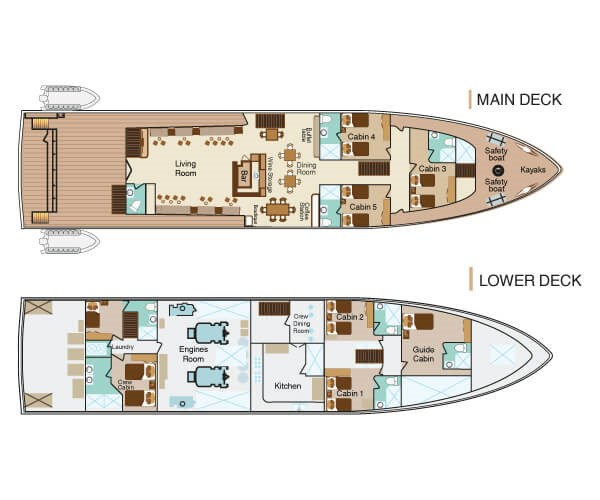
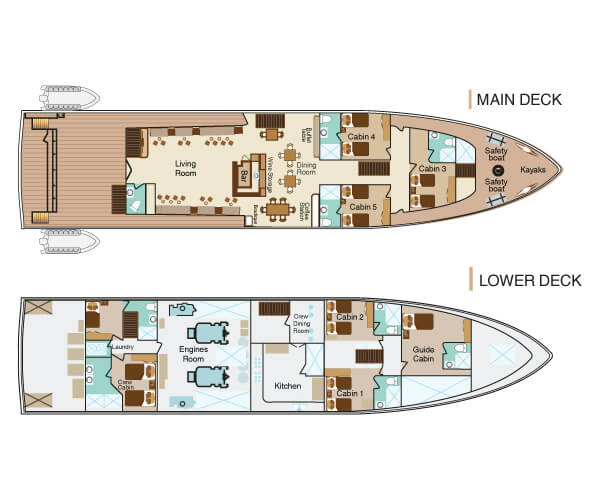



Find inspiration from our selection of itinerary suggestions, a great starting point for your next trip
View More Tours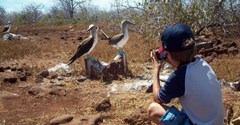
Multi-Country Landmark Tours
15 Nights from £7,297
Lima - Lake Titicaca - Andean Train Journey - Sacred Valley - Machu Picchu - Cusco - Quito - Galapagos Islands Cruise
Cruise the Galapagos Islands for close encounters with friendly wildlife and be inspired by Andean landscapes, colonial heritage and the ancient Inca civilisation at Machu Pic…
Route
Lima - Lake Titicaca - Andean Train Journey - Sacred Valley - Machu Picchu - Cusco - Quito - Galapagos Islands Cruise
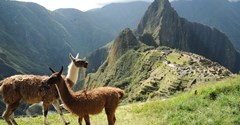
Multi-Country Landmark Tours
52 Nights from £21,228
Quito - Amazon Lodge - Cuenca - Guayaquil - Galapagos - Lima - Sacred Valley - Machu Picchu -Cusco - Andean Train - Lake Titicaca - La Paz - Santiago - Atacama Desert - Torres del Paine - Cape Horn Cruise - Buenos Aires
A journey of a lifetime from Ecuador, Galapagos and Rainforest, following the Andres to Peru, Machu Picchu & Lake Titicaca to La Paz in Bolivia, Atacama & Torres del Paine in…
Route
Quito - Amazon Lodge - Cuenca - Guayaquil - Galapagos - Lima - Sacred Valley - Machu Picchu -Cusco - Andean Train - Lake Titicaca - La Paz - Santiago - Atacama Desert - Torres del Paine - Cape Horn Cruise - Buenos Aires

Multi-Country Landmark Tours
25 Nights from £9,301
Quito - Galapagos Islands Cruise - Lima - Cusco - Sacred Valley - Machu Picchu - Andean Train - Lake Titicaca - La Paz - Rio de Janeiro
Cruise the Galapagos Islands and explore the culture and Inca heritage of the Andean region ending in Rio de Janeiro. Also possible to shorten itinerary returning from Lima or…
Route
Quito - Galapagos Islands Cruise - Lima - Cusco - Sacred Valley - Machu Picchu - Andean Train - Lake Titicaca - La Paz - Rio de Janeiro
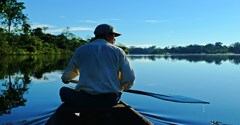
Ecuador & Galapagos
14 Nights from £6,393
Quito - Amazon Lodge - Quito - Galápagos Cruise
This tour includes the Amazon rainforest, a Galapagos cruise and an insight into the colonial charm of Quito, high in the mountains.
Route
Quito - Amazon Lodge - Quito - Galápagos Cruise

Ecuador & Galapagos
19 Nights from £8,231
Quito - Amazon Lodge - Quito - Riobamba - Cuenca - Guayaquil - Galápagos Cruise
Experience close encounters with friendly wildlife on a Galapagos Islands cruise, fascinating cultures in the Amazon rainforest and awe-inspiring volcanoes in the Andean mount…
Route
Quito - Amazon Lodge - Quito - Riobamba - Cuenca - Guayaquil - Galápagos Cruise
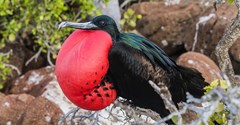
Ecuador & Galapagos
14 Nights from £7,903
Quito - Riobamba "Avenue of Volcanoes" - Cuenca - Guayaquil - Galapagos Cruise
Visit mountain villages with local markets, admire spectacular volcanoes in the Andes and enjoy a cruise in the Galapagos Islands observing the abundant wildlife
Route
Quito - Riobamba "Avenue of Volcanoes" - Cuenca - Guayaquil - Galapagos Cruise
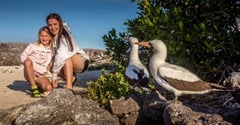
Ecuador & Galapagos
13 Nights from £5,887
Quito - Galapagos Cruise
Explore Ecuador's natural wonders including a 7-night Galapagos cruise with close encounters with tame wildlife that will inspire youngsters to develop an appreciation of the…
Route
Quito - Galapagos Cruise
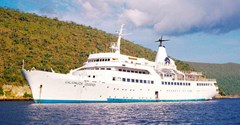
Ecuador & Galapagos
9 Nights from £6,367
Quito - Galapagos Cruise
Explore colonial Quito for 2 nights and discover the Galapagos Islands on a 7-night cruise of a lifetime. Veloso Tours provides expert advice on the best ship and itinerary to…
Route
Quito - Galapagos Cruise
Specialist Advice & Ideas
Since 1999, we focus on carefully crafting unique and authentic travel experiences in Latin America and beyond.
Create Your Perfect Tour
Your holiday is tailored by our specialist advisors to fit your preferences using our extensive kowledge of each destination
The Best Local Guides
We have developed an extensive network of expert local guides, hand-picked to provide exclusive excursions and authentic insights.
Travel with Confidence
Our local guides are your hosts providing support, information and so you visit the main sites and experience life like a local.
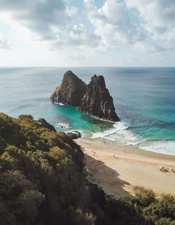
Infuse your travels, with inspiration from our monthly newsletter.
LANDMARK TOURS: Multi-Country & Cross Continent. New Cosmopolitan Tour: Buenos Aires, Iguazu, Rio
PERU: Citadel of the Incas, Mountains & Rainforest
CHINA & INDIA: Local Life, People & Unique Cultures
GUIDES by Veloso Tours, are the best Local Hosts
PRIVATE VILLAS: Quality Time in exclusive settings
TRAVEL INSURANCE with extensive COVID-19 cover